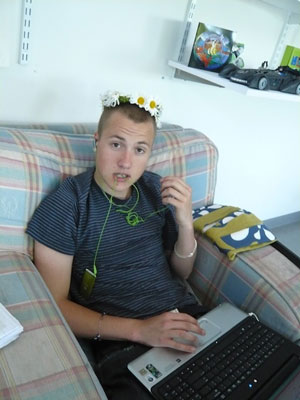My intention in taking on this MA in interactive media is to further the work that I do with digital technology in the context of secondary school arts teaching.
While I am keen to develop my own skills, I am primarily interested in how I can integrate digital technology with the teaching of art, and how I might enhance this teaching with digital technology, making the teaching more creative and the learning a more rewarding experience.
It is fortuitous that I have embarked on developing this work in the European year of Creativity and Innovation, as this has heightened the debate on the role of digital technology in schools, and the role of pupil led learning, and learning outside the structured curriculum, classroom, and examination system. The word ‘creativity’ seems to be synonymous with any current tract on the future of education, and the assimilation of digital media into the education system. Key words and phrases beside ‘creative’ seem to be mobile, knowledge, blurring the boundaries, enabling, pupil centric, co-operative, learning to learn, wide, innovative, sharing, intergenerational.
My own early experience in computing, other than digital photography and desk top publishing, was with the (ongoing) creation of a database for departmental administration. I became hooked by the creation of this database, which became like a huge three dimensional structure, almost a sculpture, only ‘visible’ to me. I taught myself a great deal about computing without going out to learn about it, but thought finding a passion. As a teacher my leanings have always been towards the left, from a visit that I made to Summer Hill in the early 1970's, visits to Waldorf schools and the Satish Kumar's Small School, in Devon, thoughts of de-schooling and work with forest schools, and communities such as Monkton Wyld and Lower Shaw Farm. And 25 years of teaching art in a Quaker school. Although maybe my fascination with digital technology has not always sat easily with these leanings, I noticed from the beginning, in buying an Amiga for my art room in the mid 80's, that students, boys in particular, who might not otherwise be interested in drawing, painting or sculpting, would spend hours glued to the screen often creating fantastically intricate work. I was also fascinated by the fourth dimension - time - and the magic of interactivity in particular. I saw a vast vista (no pun intended) of what Bob Hughes terms 'possibility space'. My over-riding notion is that my role as a teacher is to inspire this passion in others.
This section is mostly a montage of quotations that need to be organised and collated to create patterns of explorations and thoughts. With time I would organise this, but currently I feel there is so much more reading to be done. As this is 'developing practice' I am inclined to leave the crafting of this information, and creation of my own stance, until the coming year. As with my collection of web sources, I am quite keen to keep this section as a montage of quotes and thoughts.
I have been looking at a wide range of sources and articles, but particularly at those that bear on the following areas;
- working with excluded teenagers and digital media
- working with creativity and digital media
- letting students have autonomy, make the decisions, take ownership
- working with mobile technology
- working with cloud technology, web 2.0 applications and open source
- social networking technology
- games and play - having fun and being engaged
- co-operative, collaborative, group work within and across age groups
“Finally this shift in understanding is important at a time when mobile digital devices are becoming far more sophisticated and more widely available. Through this we will see the tangible divide between formal and informal learning becoming increasingly blurred. The range of hardware and software available is changing very quickly. Schools need to be aware of the options and understand how to build on them and make the most of them. These changes offer real opportunities for school leaders to envision the future of learning in ways that build on the life styles of young people”.
Their Space, Education for a digital generation, Green, Hannah, Hannon, Celia, Demos, 2007, P27
“Children - seemed, often, to be so at ease with the kit and the world of digital media that they were ‘at risk’ of being held back within school. Digital media also seemed to be a great way for them to bring their ideas to life, and to place them in front of wider audiences, and to shape their world. It also seemed to be underpinned by a partnership ethos, permitting children to take different roles and play to different strengths within a project or ongoing programme. And finally, digital media and the communication and ideas economy, like children, are the future - we don’t make cars anymore”.
blueboard, Matt Little, Director, Creative Partnerships, 2006 P13
The pedagogy of the Hat and the Sofa


.
